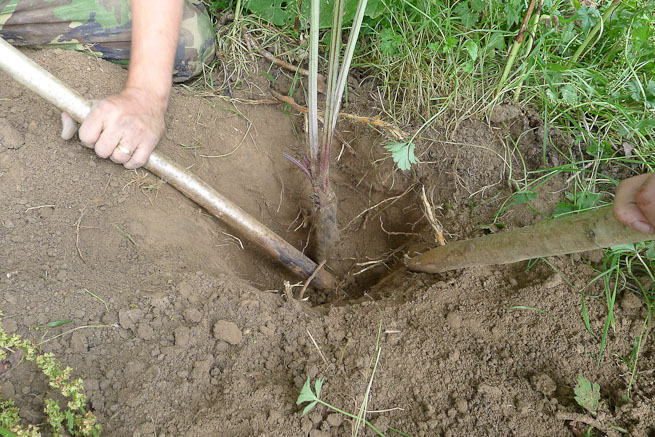
Five Survival Plants Every Forager Should Know
In a previous article I outlined a realistic approach to survival foraging.
In such a situation, you would have nothing stored or preserved from previous seasons, little or no gathering or processing equipment (such as baskets, bags or grinding vessels), limited experience and possibly little or no familiarity with the geographic area.
In short, if you do find yourself needing to keep yourself alive from only what you can forage, you are starting from a tough position.
Types Of Plants To Identify For Survival
What we need to learn first, so that we can stand on our own two feet and feed ourselves (at least for a little while), are plants that are:
- Easily Identified
- Widely Distributed
- Relatively Common
- Easily Processed
- Available (for a good portion of the year)
- Providers (of a favourable return on energy invested)
** Remember EWREAP (pronounced “You reap”)
Studies have shown that taking on only 500 calories of starchy, carbohydrate-filled plant food per day will maintain your digestive functions and provide enough energy to significantly reduce muscle loss compared to eating nothing. So this consideration should also inform the types of plant foods we prioritise when living off the land.
Five Plant Foods To Look Out For
Four of the five foods featured in this article are roots, tubers or rhizomes. All of these are underground storage organs or USOs. While different, they all serve a similar purpose, the storage of energy so the plant can grow and complete its lifecycle. This energy, preferably stored in the form of starch or other digestible carbohydrate, is what we want to get at.
You Must Follow This Simple Rule
Because USOs are not visible above ground, we need to take some care to make sure we have collected the correct one, not some underground part of another plant growing nearby:
a) Since you can see only the aerial parts of the plant – the parts which are above ground – you need to become familiar with these parts and be able to positively identify the plant from them;
b) When digging up the underground parts, you should keep the aerial parts of the plant attached. This way, you definitely have the underground parts of the plant you have positively identified, nothing else.
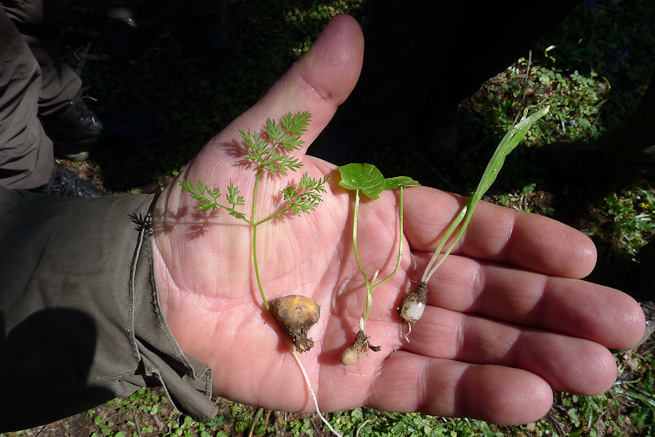
Cat-tail
Greater reedmace, Typha latifolia, and lesser reedmace, Typha angustifolia, are both wetland plants that look very similar. They are commonly referred to as cat-tails due to the shape of their flowers/seed-heads. Cat-tails are widely distributed around the Northern Hemisphere. They also occur in South America and parts of Africa, as well as having been introduced to many other territories, where they are often considered an invasive weed.
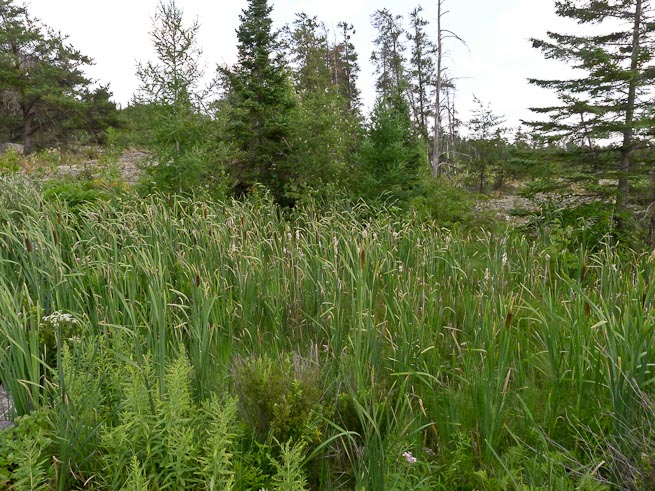
The plants grow in shallow water and wet mud at the margins between land and bodies of water. They will grow in slightly salty water but are predominantly freshwater plants. Greater reedmace in particular tends to out-compete other species and can grow to dominate an area with a large stand. This might not be great for your garden pond but it is fantastic if you are relying on them for food.
When mature, they are tall plants, reaching over 2 metres (6 feet), with long, green strap-like leaves. They form a distinctive brown structure (the female flowers) towards the top of a long, straight central stem. Some people see a resemblance to cigars, others to sausages. Later, these are filled with a mass of downy seeds.
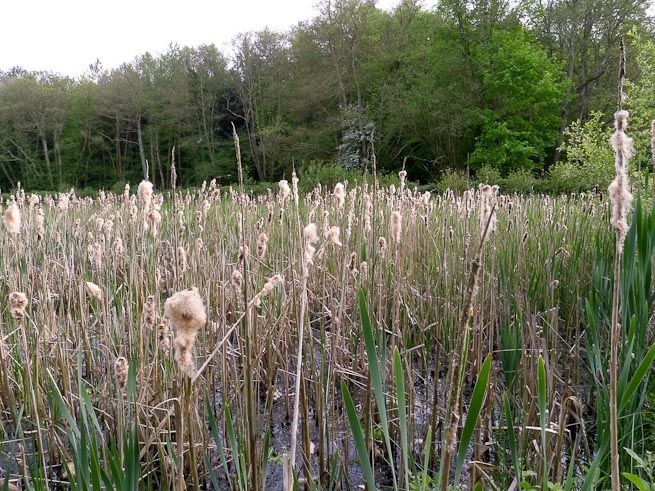
Cat-tails have many uses and several parts the plants are edible. The parts we are primarily interested in for survival food are the ropey rhizomes at the base of the plant. These rhizomes grow horizontally from the base of the plant and eventually allow new shoots to grow upwards. The energy required for this new growth is stored as starch in amongst the fibres at the core of each rhizome. For us, they also have the advantage of providing a source of food year-round.
There is archaeological evidence that cat-tail rhizomes were processed a long way back into pre-history, possibly for flour. Analysis shows that when the rhizomes are processed into flour, around 52% is available carbohydrate and 9% protein. This flour provides around 266 kcal per 100g. Cat-tail rhizomes are therefore a highly valuable source of carbohydrates and energy.
You don’t, however, need to process them into flour to obtain their energy benefit. The starch is at the fibrous core of the rhizomes and this is surrounded by a spongy layer with a skin on the outside. Simply place the rhizomes on a bed of embers and cook them until they are blackened and the spongy layer has withered. This takes around 15-20 minutes.
Once cooked, break open the rhizome with your fingers, exposing the fibres in the centre and suck the starch from them. It is somewhat sweet, with the taste like a cross between sweet potato and roasted chestnut.
To absolutely positively identify cat-tail plants, you must look at the cross-section of the leaf. It should be a shallow crescent shape, like a new moon. If it is any other shape, it is not cat-tail.
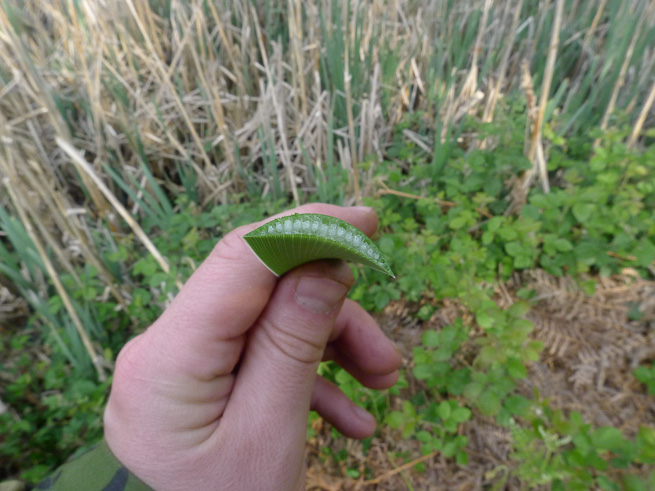
Another plant species with leaves that look similar to cat-tail are Iris pseudacorus, or yellow flag, which also shares a similar ecological niche to cat-tail. It grows in shallow water and damp or swampy ground, often alongside cat-tail. Yellow flag also has rhizomes. To the experienced, the rhizomes of each plant are very different but to the inexperienced there is the potential to make a mistake; like the rest of the plant, yellow flag rhizomes are poisonous. The sap of the plant can also cause skin irritation.

When a yellow flag plant is in flower, it is quite obviously not a cat-tail but this particular distinction is only clear for a short period of the year. We need a more widely-applied way of telling the plants apart. Looking at the cross section of a yellow flag leaf, you will see it is quite different to that of a cat-tail leaf. The yellow flag leaves have a cross section that has a central diamond-shaped rib with a very thin leaf structure either side.
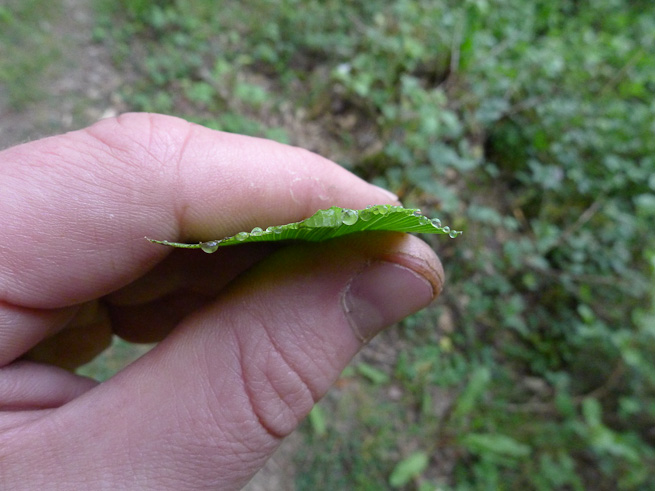
Comparing the leaf cross-section is a highly reliable way to tell the two plants apart. And remember, you must recover the cat-tail rhizomes while they are still attached to rest of the plant, including the leaves you have positively identified. You absolutely must not reach down and pull out of the water or mud any structures that you think are off the cat-tail plants. Not only could there be yellow flag rhizomes down there, there could also be the roots of hemlock water-dropwort, Oenanthe crocata, which has been the cause of many fatal plant poisonings.
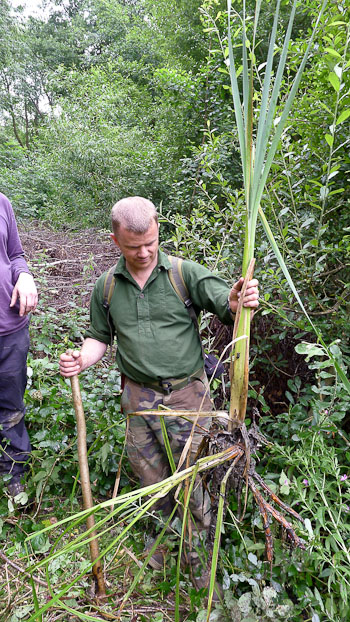
While the potential proximity to poisonous plants may put you off cat-tails, it shouldn’t. They are easily identifiable, widely distributed, common, easily processed, available year-round and provide a very favourable return on energy invested.
Cat-tails are the single most important plant-based survival food in the Northern Hemisphere. You should get to know these plants.
Burdock
Like cat-tails, there are two burdock species we should consider. For the purposes of survival food, we can treat them as one. Greater burdock, Arctium lappa, and lesser burdock, A. minus are quite closely related to thistles. This familiar relationship is most easily seen in the flowers.
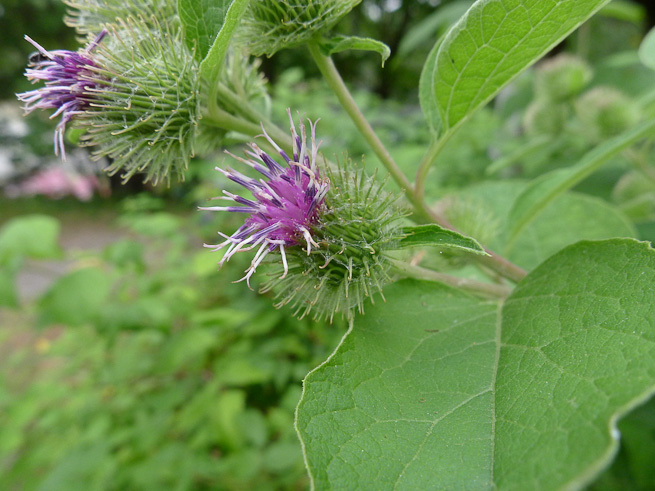
The leaves of burdock on the other hand are quite different to those of thistles. Burdock leaves are large, quite flat and heart-shaped, with wavy edges. They more resemble rhubarb than thistles.
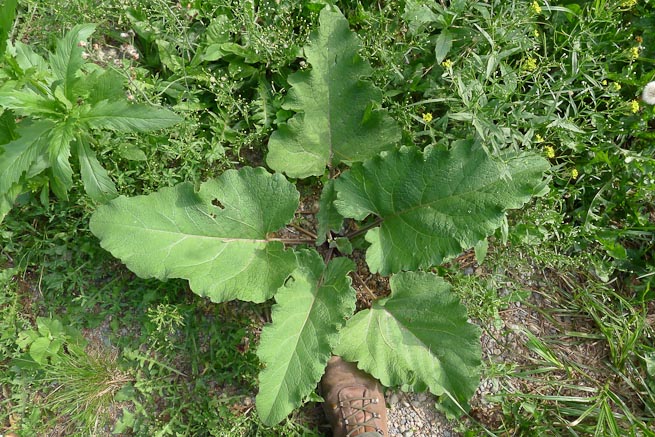
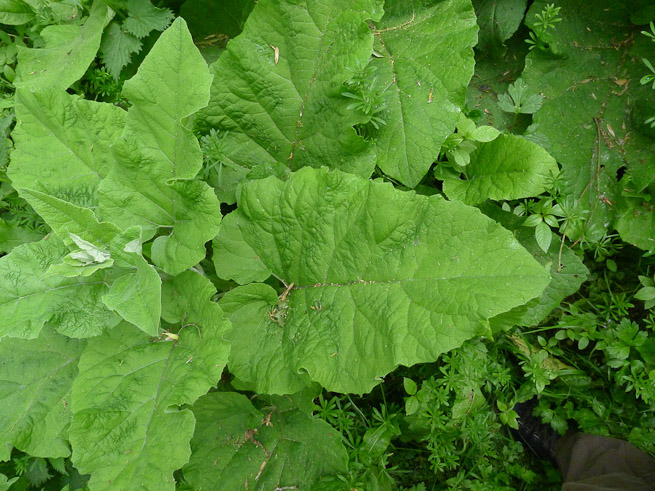
Burdock has a wide geographical distribution in temperate parts of the world with these species being found throughout Europe to Russia, the Middle East and Asia. Burdock is popular in Asian cuisine. Both lesser- and greater burdock are thought to have been introduced to North America from Europe. Lesser burdock is by far the more common of the two in North America, where it is known as common burdock.
One of the most important things to understand about burdock is that it is a biennial. This means the plants complete their life cycle over two years. In the first year they put out big leaves that act like solar panels, collecting energy from the sun by photosynthesis. This energy is stored as starch in a large root. The plant’s leaves die back over winter but in the second year of life, the plant uses the energy in its root to send up a tall flowering stem, on which will be the plant’s prickly seeds. These seeds are then spread and the two-year process is repeated by new plants.
It is the root that we are interested in as food. This USO is a good source of the carbohydrates we are looking for. It will have most energy in it from towards the end of the first summer through to the beginning of the second spring. Plants with flowering stems – either developing or developed will be in the second year, so we will ignore these. Plants with broad rosettes of large leaves – and no flowering stem – are in their first year of growth and the ones we are looking for.
The one downside of seeking out burdock as a source of food is that it can take a bit of effort to dig up. The plants typically like to grow in ground that is reasonably hard and the tap root tends to be long and very well fixed. You certainly cannot just pull it up! In the absence of a shovel, you should make and employ a digging stick. Break up the ground with the stick then scoop out the loose earth with your hands.

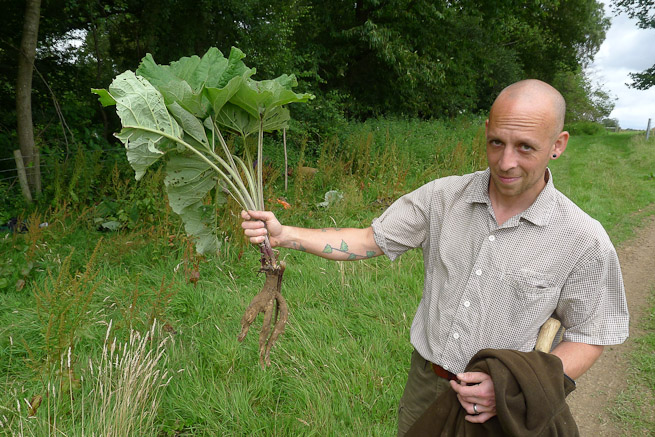
Burdock roots contain a significant proportion of inulin – a form of plant energy that is indigestible by humans. But the roots also contain accessible energy and the roots provide around 72 kcal per 100g (raw, not dried), with 17 g of carbohydrate and 1.5g of protein. This is a very similar profile to the potato.
You can eat burdock roots raw (like a carrot) but where they are used in cuisine, they are typically cooked. Cut them into batons then stir fry them or slice thin then add to a stew or soup. If you are without cooking apparatus, you can cook them whole under the fire but it takes several hours for them to cook through.
Pignut
The pignut, Conopodium majus, is common in many parts of Europe and its range extends to North Africa. Pignuts grow in open woods and in well-established (and ungrazed) grassland. In the woods they like to grow in areas that receive a reasonable amount of sunlight. On bright spring days you’ll spot pignut leaves in areas of dappled sunlight, often right beside the trail you are walking along. The plant likes well-drained soil.
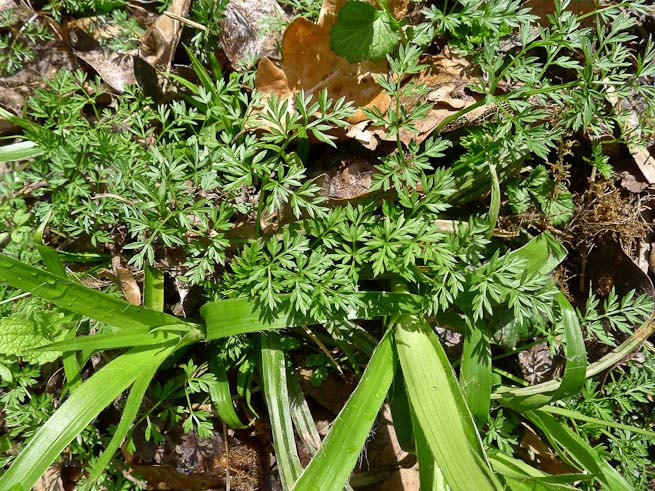
Again, it is the underground part of the plant, specifically the tuber, we are most interested in. The tuber is edible all year round. Pignuts are one of the more palatable wild foods. The tuber can be eaten raw and is very tasty. In flavour and consistency pignuts are something like celery heart crossed with raw hazelnut or sweet chestnut and sometimes have a spicy aftertaste of the sort you get from radishes or watercress. Pignuts can also be added to soups and stews to increase carbohydrate content.
Pignuts have been found at archaeological sites dating back to the Mesolithic and these have mainly been interpreted as a potential food resource. There are also accounts of pignuts being utilised for food in times of famine during the eighteenth century.
The first opportunity you’ll have to gather pignuts is in the early spring when you see the leaves appearing. As the plant flowers in late spring/early summer, location and identification continues to be easy until the flowering stem dies back. After this time, however, there is no above-ground sign of the plant unless you leave markers.

The pignut is in the carrot family, or Apiaceae, and the leaves do bear some resemblance to carrot, at least in structure. As a general rule you should be wary of this family of plants as it contains some very poisonous plants such as Hemlock, Conium maculatum, and Hemlock Water Dropwort, Oenanthe crocata. The pignut is relatively easy to recognise from its aerial parts, partly due to their small size compared to other members of the carrot family. The leaves are finely divided, delicate and lacy.
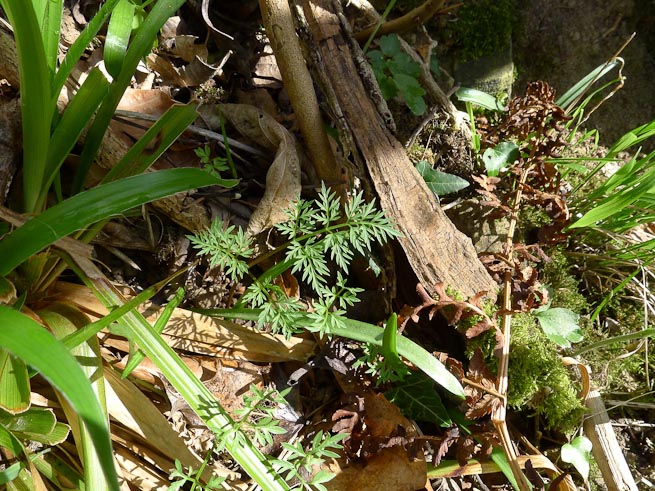
Also, in terms of distinguishing a pignut from its relatives, the tuber is unlike other members of the family. Pignuts are very un-carrot-like, typically being roughly spherical in shape. Generally, the tubers are around the size of a hazelnut or a little larger but can be found to be around 3cm (1.25 inches) in diameter.
If you keep the leafy shoot of the pignut connected with the tuber then you have a positive identification. Achieving this, however, is quite fiddly. The tuber is typically 10-20cm under ground and the shoot gets thinner and thinner as you get closer to the tuber. It is very easy to break it and detach one from the other. Pulling the nut out of the ground by the shoot is out of the question. Also, the shoot usually comes out of the side of the tuber then bends at right angles to continue its journey upwards and out of the ground. So as you follow the shoot down to the tuber, this makes it harder to identify the tuber itself as it is rarely where you think it might be.

Even though getting a pignut out of the ground can be a little fiddly, it doesn’t take much energy. You also often find many plants growing in close proximity, so you can gather quite a few in a small area. To get the tuber out of the ground, carefully dig down next to the stem with a pencil-sized stick until you locate the tuber. The outer surface of the tuber is a maroon colour, although it will be covered in soil when first removed from the ground. This outer skin is easily removed, revealing the creamy inner flesh. If you do this properly, you don’t need to wash the pignut or employ any other cleaning. You can then just eat it straight away.
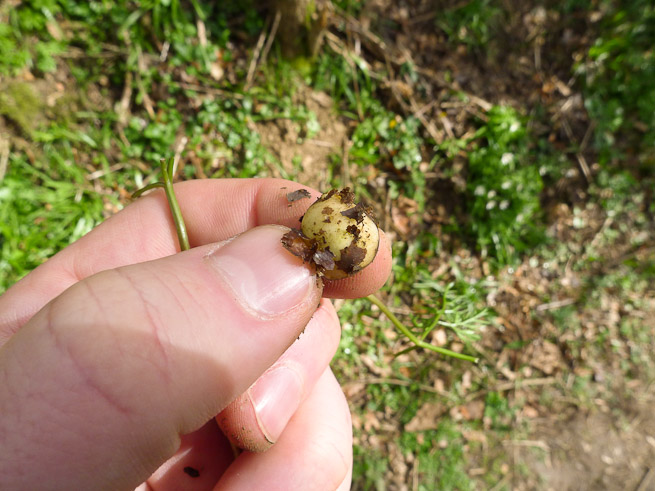
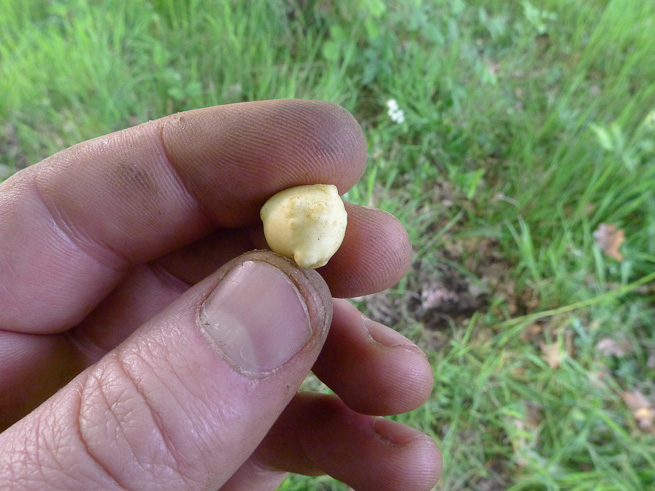
Silverweed
Silverweed, Potentilla anserina, is native right around the temperate Northern Hemisphere. It is a low-growing member of the rose family with a five-petalled yellow flower similar to many other cinquefoils. The plant has long, creeping stems and the leaves are divided into as many as a dozen pairs of leaflets. The leaflets are serrated around their edges.
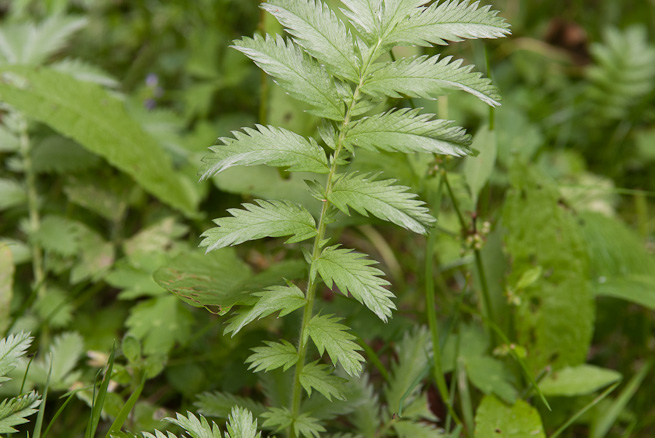

Silverweed’s leaves are what give rise to this plant’s name, being a silver-green on the topside while underneath, where they have a silky fur of fine hairs, they are grey-silver. This makes the leaves very easy to spot when the breeze catches and turns them over.
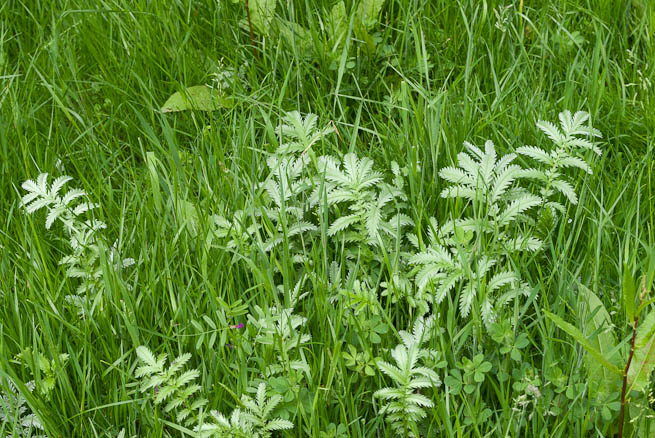
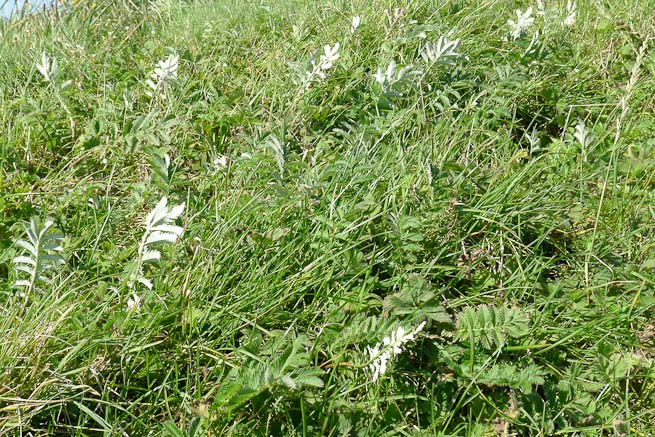
Silverweed is both widespread and common, often forming extensive carpets. Usefully it can grow in relatively poor soils where other plants struggle. Again it is the underground storage organs of the plant that contain valuable starch.
Like pignuts they are small but not particularly difficult to dig up – although harder to separate from soil than pignut – and also grow together with many other plants of the same species.
The method of excavation is different to pignuts too. Using a larger digging stick, loosen a whole area of soil and separate the plants from the soil. In sandy or shale soil, where the plant often likes to grow, this isn’t so difficult. In heavier soils it can be harder to separate the roots from clumps of mud.
The plant forms one or more storage roots containing starch. These roots are individually quite small, averaging around 5mm in diameter and 1 to 3 cm in length. Raw they are quite crunchy. Cooked they have a taste of their own that resembles parsnip blended with sweet potato. The best time to collect the roots is at the end of the summer/beginning of autumn as the leaves start to turn brown and wither. The roots are still available through the winter but with the plant leaving no above-ground indication of their presence, they are hard to find.
Records indicate silverweed was until relatively recently a very important source of food from as far east as Yakutia to as far west as the Pacific coast of North America.
Silverweed was noted as an important food for Tibetans by travellers in the early twentieth century, observing that the plant was often dug up and eaten or dried and stored for later use.
Silverweed was a staple food for the coastal peoples of what is now British Columbia, Canada. Small amounts were steamed in a box while large amounts were roasted in a pit. The roots were also dried then pounded into flour. While not farmers as per the modern understanding of the word, these people cultivated pristine swathes of silverweed.
Closer to home, in the Hebrides and elsewhere in northern Britain, silverweed was cultivated until the introduction of the potato. It was later fallen back upon as a food source during famines caused by potato blight.
History has proven these diminutive USOs can indeed provide an important survival food.
Stinging Nettle
For most people stinging nettle, Urtica dioica, needs no introduction. Personally, my earliest definite memory of the stinging power of nettles is from when I was about 7 and falling off my bike into a large patch of the plants. I’m sure I had been stung by nettles before this point, but this incident has really stuck in my mind!
Urtica dioica is native to Europe, North Africa and Asia and was introduced to North America by colonists. The plant likes nitrogen rich soils. You may have noticed old derelict cottages and farm houses surrounded by a sea of nettles. This is due to urination increasing the nitrogen levels in the soil in the area around the habitation. This means that you don’t see stinging nettles as much the further away from habitation you get. But it is still a common and widespread plant.
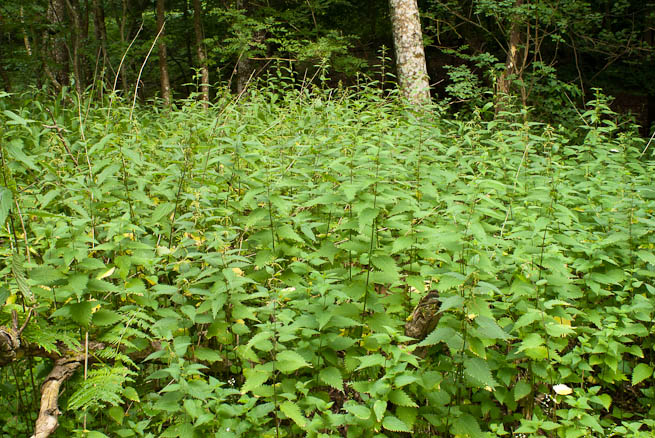
This is the only plant of the five in this article that we are not interested in for an underground storage organ. Nettles are high in protein for a green plant. Dried, the leaves can be up to 25% protein by weight. Nettles also contain a whole host of other nutrients, including iron. They are easy to collect, easy to prepare, filling and highly nutritious.
It is the fine hypodermic-like hairs on the plant’s leaves and stem that allow histamine and formic acid to be injected into your skin and cause irritation. All it takes is a small time boiling or exposed to flame to wilt the hairs and disable the stings.
To render the leaves edible, then, all you need to do is add them to boiling water for a minute or two, longer if you wish although they eventually turn to a green sludge. The taste of the leaves is somewhat like spinach although the texture is rougher. You can also add the leaves to soups and stews. The best leaves are the tender young shoots in spring which supply a welcome dose of greens at this time of year.
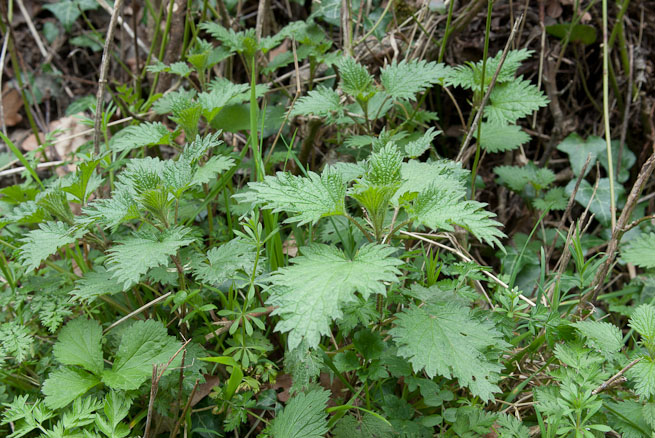
Later in the year, when plants are more mature, take the top four or six leaves. If you boil the leaves on their own, the water makes a good tea, which contains iron and other nutrients from the nettles. Beware as plants become older – particularly after they flower – they become gritty, containing particles that can cause urinary tract irritation.
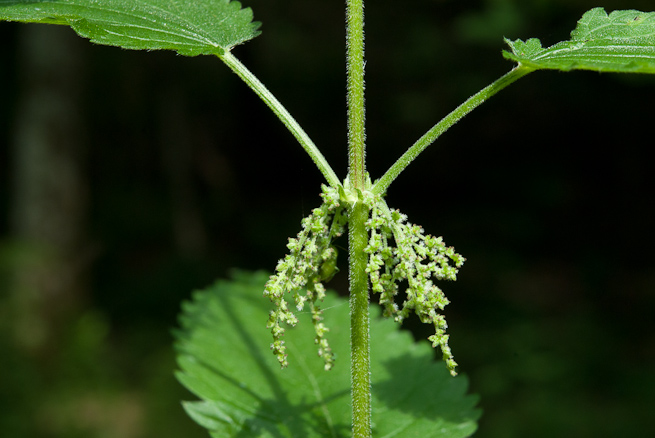
If you don’t have a cooking pot, you can simply wilt the nettles over a fire. Take plants that have stems long enough to hold them over the fire without burning yourself. Wilt the leaves over the fire then pick them off the stem. I find they are most tasty when a little crispy. The flavour is quite different to when the leaves are boiled. Even if you do have a cooking pot, nettles wilted like this can make a nice change from boiled leaves.
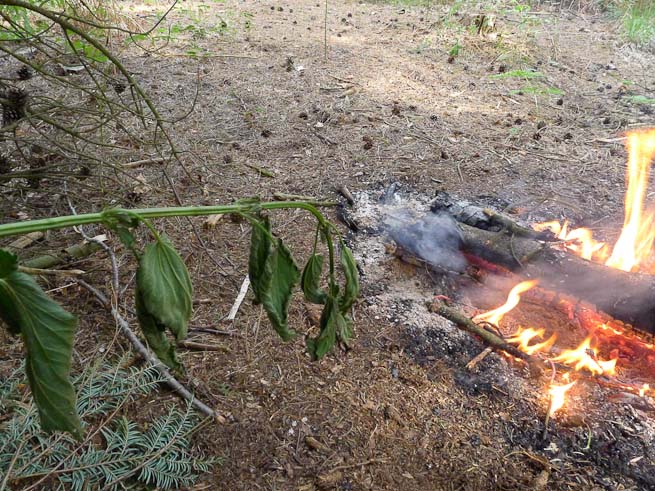
Five Plants To Get To Know
The five plants in this article are easily identifiable, widely distributed, relatively common, easily processed, between them represent available food year-round and provide a very favourable return on energy invested.
From a survival perspective, they should be at the top of your list of plants to learn.
But before you put this article down and head out to forage, please make sure you follow local laws. In the UK, unlike picking leaves from a plant, under the Wildlife and Countryside Act, 1981 uprooting a plant is illegal without landowner’s permission, even if you are collecting for personal consumption. This means for four of the five plants above you need to have landowner’s permission if you are to practice your foraging skills.
I would also recommend anyone involved or interested in collecting wild foods in the UK to read and understand the BSBI’s Code of Conduct for the Conservation and Enjoyment of Wild Plants which gives a good overview not only of the relevant legislation but also ethical considerations.
Please note: This article is not a complete treatment of all edible plants. Nor is it a complete treatment of all poisonous plants. If you want to learn more about plant identification you should invest in some good field guides. The safest way to learn about wild edibles is for someone who already has the knowledge to show you in person. Any foraging you do on your own is at your own risk.
The most important thing to remember when identifying wild foods is:
IF IN DOUBT, LEAVE IT OUT!
Recommended Field Guides:
Collins Wild Flower GuideCollins Complete (Photographic) Guide To Wild FlowersThe Wild Flower Key
Improve Your Tree and Plant Identification Skills
Would you like to improve your ability to identify useful trees and plants? I offer an online tree and plant identification course, which flows through the seasons. Find out more about the next available course by clicking the following link: Paul Kirtley’s Tree and Plant Identification Masterclass
Related Articles on Paul Kirtley’s Blog:
Conopodium majus: Pignuts and How to Forage for them
106 thoughts on “Five Survival Plants Every Forager Should Know”
As usual an excellent and informative blog entry. I do enjoy reading these.
Thanks Paul
Thanks James. You’re most welcome.
Hi Paul, excellent article, will be passing this on again. The ground around where I live is a hard clay soil, which makes digging for Burdock and Pignut a test of patience, still the end result is worth it. Never tried the Silverweed , a bit scarce on my area. Cheers Paul.
Thanks Darren.
Hi Paul , great article as always I have experience with all of the above plants as food and enjoy other information and takes on them from people who have actually tried them ,in particular with burdock I’ve been surprised on the quite strong change in flavour depending on how it is cooked
Thanks for the blog
Great article. The more I read about foraging, the more I realise how little I know about all of these plants that I thought I knew quite well.
Thank you for this Paul. Useful as ever.
You’re very welcome Niels.
Another great informative write up … cheers paul! Our farm is literally laden with all 5 of the species you mentioned, and apart from the silverweed ive tried them all with various methods of cooking. Silverweed will most certainly be next on my foraging menu. Thanks once again!
Ahh, great stuff. Sounds idyllic. Let us know how you get on with the silverweed.
Cheers,
Paul
Since you have a farm, learn to identify a few of the edible mushrooms that grow around compost and manure piles. Lots of good nutrition there, as well as a veritable medicine chest.
No single plant or small group of plants can be absolutely relied upon for nutrition. These five are generally available in the zone indicated, but the broader your knowledge, the greater your chances of success.
Very interesting and very good picture idents.
Thanks Carelton. Glad you liked the pics as well as the text 🙂
Another great article ! Keep it up.
Thanks John!
Fantastic detailed and informative article as usual ! Reedmace also known as the Duke of Argyll’s Teaplant…. Which i hope means there’ll be plenty in Argyll, since I’m spending best part of August there in riparian woodland!
Thanks Linda. Have a great tea-time in Argyll! 😉
Best,
Paul
duke of argyll’s teaplant = lycium barbarum (or goji berry)!
not reedmace.
🙂
Hi Paul, Reading these article are GREAT! any chance of some recipes to go with this top five food group?
Hi Carl, thanks for your comment – good to read you’re liking my articles.
I’ll some how-to-cook articles to my list! 🙂
Best,
Paul
Google ‘cattail recipes’ or ‘burdock recipes’. Paul has enough on his ‘to do’ list 🙂
Hi Paul, I love reading your articles and often go back and re-read them. This one is as great as ever, informative, easy to read and useful photographs to support the text. I also really appreciate having the email that is sent out to direct me to your articles. Thanks for taking the time to share your knowledge! Kind regards, Louise
Hey Louise,
You’re very welcome. Thanks for the feedback – it’s great to know that what I’m doing is working and useful to you.
Warm regards,
Paul
Paul,
Thanks for the plant information. I am very familiar with both the cattails and stinging nettles as they both grow prolifically here in Kentucky. The nettles grow along all the river banks and the cattails grow around all the ponds and lakes.
Thanks…Steve
Hi Steve,
Thanks for your message. It’s great to hear from someone in Kentucky!
It’s also great for readers of this article to know that they are likely to come across the featured plants far and wide.
Warm regards,
Paul
Hi Paul,
When this article came out , I felt bewildered…so many plants, what do I do? I decided to stick to a few, or may even one. …munching and chewing on the info slowly….I happened to go another family bushcraft weekend..with my young one…and this time…the plants made sense…whoopee! I was able to identify the stinging nettle amongst the others, burdock…and even managed to remember how to keep the roots attached . some recipes were discussed as well…and it was interesting to exchange notes from around the world. Came back and then went back to your notes to see what I had learnt. Now it made more sense…maybe I should do this scrap book where I put the leaves, my notes and then print a bit of your blog…truly so much info over period of time. Thanks again!
Hi again Leena,
I was happy to read you’d had such a fruitful weekend.
I’m also glad that the plants are now starting to slot into place and make sense.
I think a scrapbook of leaves is an excellent idea. I used to do something similar when identifying trees.
Warm regards,
Paul
Hu Paul,
Another brilliantly clear and well explained article, which will come in very handy! I do some work on an educational nature reserve where the pond is choked with reed mace, so there is no shortage of that..
I am just a little intrigued by the pignut, as Ray Mears (Wild Food) says that it is illegal to dig them up nowadays. I usually trust Ray on these things and I know that you make the point about landowners’ permission, so I would go with your excellent and more recent article. Any thoughts?
Thanks again,
Terry
Hi Terry,
It’s good to hear from you. Thanks for your feedback on this article. Great that you have a lot of reedmace to go at. 🙂
As for digging up pignuts – it’s illegal to uproot any plant without landowners permission, including pignuts. I believe this is what Ray was referring to.
Warm regards,
Paul
amazing and very interesting artical
Thanks
Hi Ben, thanks for you feedback. I’m happy you found the article interesting.
Warm regards,
Paul
Very useful artical Paul. Now i have a starting point for foraging and learning.
That’s great Gosse. Thanks for your feedback.
Warm regards,
Paul
fantastic article paul really enjoyed reading it. have only eaten nettles before in rabbit stew, ;-( and fresh tops ;-). going to try crisping them. got to roast some burdock now,cant wait. thanks for sharing . you have given me yet another bushcrafty thing to put on my ever incresing “to do list”. hope to see you on another one of your excellent courses. cheers mate 😉
Hello Paul, very clear and informative. I always learn new things from you ,the cattail and burdock info is most useful too me . Thanks again for the many good lessons you taught me ,and for the ones I teach after me too others, in your name . Ron Lowatchie
Great article Paul. Luckily I know them all thanks to your expert tuition on the various courses I’ve been on with you 🙂
Thanks for your comment Steve. It’s good to hear from you and even better to hear that all these plants are familiar. But that’s because you’ve tried them all I guess and that’s what makes the difference :-). Cheers, Paul.
Nice Paul. Very good read! I also am from Kentucky. We have all 5 here and i have not eaten any of these yet but will try them for sure. Thank you so much buddy.
Hi Rob,
Welcome in and thanks for your comment.
Thanks for confirming that all 5 are found in Kentucky.
Let us know what you think of them, once you’ve tried them.
Warm regards,
Paul
Your article on the five plants is very informative…. I only wish you or someone like you would do it for North America and in particular the West Coast of the US (that is where I live). I have found all too often the info that I read is either in black and while photo’s or if they are in color only a few photo’s and really not as helpful as your article above. Keep up the wonderful work that you do. I look forward to readying you next article.
Hi Stephen, welcome. Whereabouts on the West Coast do you live?
Warm regards,
Paul
Los Angeles Cal.
Los Angeles Cal
That’s good to know. Thanks Stephen, I’ll bear that in mind for future content.
Best,
Paul
Hello Paul. Burdock, silver weed and nettles are tenacious ‘weeds’ in my West Country garden. Your article has changed the way I regard them! I don’t recall seeing any pig nuts but will be out looking in the spring. As cat tails require standing water I am less familiar with them, and I will need to search wider; I have always known them as bulrushes, probably because of the Bible story of Moses being hidden in the bulrushes. Could cat tails be used for weaving such a basket?
James de Ferrars
Hi James,
Thanks for your comment. I’m glad that this article has inspired to look further afield as well as more closely for these food resources. It will certainly be worth the effort.
As for bulrushes, there is always some confusion due to the multiple use of “bulrush” as a common name. While “bulrush” is used as a common name for Typha, it is more correctly applied to the genus Scirpus, with Scirpus lacustris being considered “true bulrush”.
While Typha is certainly a useful species for weaving mats and other structures, it is thought that the species referred to in the bible was likely Cyperus papyrus.
Both the Scirpus and Cyperus genera belong to the family Cyperaceae, more commonly known as sedges.
Hope this helps.
Warm regards,
Paul
Hi Paul,
Another brilliantly put together article. WIll definately have a go at this, with care. The stinging nettles really appeal to me. I think doing just a few items in real detail is much better than the plethora of information out there, which can be a little confusing.
Kind regards,
Adrian
Hi Adrian,
Nice to hear from you. Please do check out these plants but, as you say, do so with care. All of them are relatively straightforward to identify as long as you follow the basic rules of identification of the particular species as well as ruling out similar toxic species (such as iris).
I completely agree that there is no filter out there – lot of species are taught as edible but which should be prioritised? Which ones should be learned first should, in my opionion, be driven by their importance. You can then layer less valuable/less common species on top to fill out your knowledge.
Let me know how you get on…
Warm regards,
Paul
thank you paul,…!!! ^_^
You’re very welcome Roby!
A wonderfully well written and illustrated article which is of great use to anyone just beginning to investigate wild edibles. I will be printing this article and taking it into the field. Thank you Paul.
I very much appreciate Paul’s dedication to informing others about how to sustain themselves in the wild. I share it on several Facebook groups and it is well received. I highly recommend subscribing for email updates and new articles.
Hi Clay, thanks for your kind words. I very much appreciate you sharing my articles. All the best, Paul
Hi Paul love getting all this info from you I read or watch everyone you send. I thought the good old dandelion would have been one of them since they have so many uses. Thanks for all your work.
Hi Kevin,
It’s great to hear that you are managing to squeeze so much from this site. That makes me very happy.
I agree Dandelions are very useful but there can only be five in a top-five 😉
Maybe I need to write a top-ten?
Keep in touch.
Warm regards,
Paul
I’m sure we’d all appreciate a Top 10! 🙂
What an interesting article. Very comprehensive and I especially like the extra info on historical usage of native plants. Great stuff.
Hi Greg,
Thanks for your kind feedback. I’m glad you found this interesting and useful.
Warm regards,
Paul
Dear Paul,
I’ve been enjoying your blog and videos for the last several months since discovering them. I live in the beautiful state of Maine here in the US, which provides vast wilderness. I’ve been an avid bushcrafter all my life before I knew what it was. Thank you for all your insights and helpful education on the subject. You’ve inspired me to start my own channel on Youtube and devote time to helping others. If your schedule ever allows you to view my channel, Wilderness Academy, I would appreciate your feedback. Perhaps I will come across the pond for a school sometime.
God Bless You,
Tiff Shuttlesworth
Hey Tiff,
Thanks for your message. I’m humbled that you have been inspired to start your own YouTube channel. I shall certainly check it out.
I’ve yet to find my way to Maine. I would very much like to visit one day – it’s on my list 🙂
You’re fortunate to have all that space on your doorstep. Enjoy!
Warm regards,
Paul
Hi Paul great article as always,enjoyed reading it,we have loads of shallow ponds with cat-tails in my area and i will look out for the other plants as well,thanks you very much kind regards.Baz
Another enjoyable read Paul.
Would greater plantain be another viable choice? I see it everywhere
Many thanks
Ian
Hi Paul
Springtime is almost here, and it will be time o forage greens! Outside our mountain home we have
considerable wild edibles. Nettles provide an excellent and tasty steamed green. Cattail surrounds the
trout lakes, and the edible pine species prolific. In season huckleberries are delicious. Its’ amazing how
many plants grow commonly world-wide.
Kind Regards
Jim
Pacific Northwest
Very good article lots to try and learn and remember keep it coming
Thanks Dave. Will do.
Now this is more like it! Feel more more confident on id now. Clear info, tips and pictures. Keep up the good work Paul. Love your blogs.
Cheers
In S
I read this post fully regarding the difference of most recent and preceding technologies,
it’s awesome article.
You never stop learning – Silverweed is one I did not know about – I’ll be looking for some later!
Hi Paul!
I was often in nature and picking edible plants, but with these your
the words I have learned a lot more.I hope that we will much more learn in the future
from you, on survival in nature.
Kindest regards !
Bozidar Croatia
Hi Bozidar,
I’m happy you found this article educational and useful.
Thank you for the feedback.
Warm regards,
Paul
Hi Paul
I enjoyed this article for its simplicity.It is nice to see just Five very useful plants in this easy to remember format rather than being confronted with a whole book full.
I always have plenty of nettles at the bottom of my garden so will be giving them a try I had a go at making cordage from them a while back and that was a success.
Many Thanks
Alick
Hi Alick,
Thanks for your feedback – it’s much appreciated.
I’m glad you liked the clarity/simplicity here.
Cheers,
Paul
Hi Paul, thanks for your article.
Think it’s very difficult for someone to exist on just 5 plants due to location and season. I also know that to exist in nature you have to use all and every plant and wild food available to you. You will be surprised just how many calories you actually do need if you are out’n’about actively, and just how much weight you loose if you practise this for months on end rather than a weekend….
Anyway these are my top five in the UK, and for sure the most important plant in my opinion is the cat tail. I think that the pignut is too fiddly and although a nice&tasty treat think there are easier gathered calories.
1-Hawthorne-leaves&flowers raw(spring), berry flesh(not seed) raw (autumn)
2-Burdock-rootstock cooked(year round)
3-Cat tails-bottom of stem &rhizome raw or better/safer cooked (year round)
4-nettle- boiled (6mins) for food & tea. Stems for cordage(almost year round)
I’m torn between number 5 but think
5-Dandelion- leaves raw or cooked, roots boiled as food or roasted as a coffee substitute(most of year)
Or
5-bramble/blackberry-leaves for teas (most of year) and berries raw (autumn)
Or
5-Plantain- leaves cooked (year round)
Keep glowing, respects dOm
Paul,
I live in East TN, USA,
There are several national forest near me as well as the Smokey Mountain National park, also an abundance of current farmland or abandoned farmland. I feel it is important to understand that most (at least a lot ) of the abundant foraging will most likely occur on cultivated land or land that once was.
TVA lakes (major lakes made mostly for flood control and electrical generation) and ponds are abundant.
The only plant of the five that I cannot find easily is the “pignut” but there are others that were not in your list that will work out well for me.
I am recovering from an injury which pretty much took me out of the walk-about style living this summer and this fall as well, but one of my goals is to survey what can be done as far as true foraging in my immediate area this coming year ( this includes animal protien ).
I think that with care, that I live in a sweet-spot for survival. The truth of this will be found out by me over the next year.
Thank you for your post and in particular the dangers of incorrect identification of the food plants.
Excellent article, probably the best I have seen on the particular subject of foraging for survival, and one of the few to mention the importance of high-return for little effort.
If I might make one small addendum–don’t ignore the burdock that has already sent up a flowering stalk. Though you wouldn’t go for the roots of these plants, the pealed stalk is an excellent vegetable. It lacks the starch of the root, but contains a decent amount of sugars (therefore calories) and some nutrients and requires very very little energy to cut, peal and eat. It can be eaten raw and is thick and often tall–a good amount of food for little effort.
Hi Paul I like to read all your survival techniques i found this one very interesting particularly the one on the pig nut I’ve tried a few times to find the nut but give it up because I wasn’t 100% sure it was a pig nut but I now know it was thank you for all your survival and foraging techniques. Top man
Thanks so much for this Foraging Wisdom… But I live in The Tropics that’s why it is still very hard for me to identify these plants… I am only familiar with the “Coconut Tree, Dandelions, Oje Tree, Cannonball Tree, The Pichirina & The Barbarosa Tree which is prevalent in Asian Islands… I Would love to have the chance to see them once I visit Europe or The US in the near future… Cheers!
Hello Paul,
Have been a ‘Lurker’ until now (and have been enjoying the quality of the material on both the ‘ask Paul’ and around here). Please keep up the good stuff 🙂
I have been foraging in the past for different plants (Plantains and sorrel/rumex f.e.), but had been taught that for nettles you need to blanche them and then change the water to get rid of the ‘bad stuff’. As you would then also throw away quite some nutrients i had left nettles alone because the effort and fuel needed for preparing them would not balance the benefits of the final result in my opinion.
Could you enlighten me on this please?
ps: in the Netherlands ‘wildplukken’ (wild picking) is illegal though most large landholders will tolerate picking for personal use in small amounts (direct consumption of blackberries is OK for example, but taking buckets full for making a lot of Jam is not 😉 )
Dom
Hi jeoren, another good and much quicker way to make nettles safe to eat is to simply wilt them over a fire. Leave the leaves on the stem and turn them over a fire (like marshmallows), until the leaves all wilt and turn colour. This is very quick depending on your fire size/heat, maybe 5-10seconds, rotate and same again. This method removes the sting (the moisture in the nettles steams them) and you retain even more nutrient than boiling. Also much tastier this way ;0)
You will still need fire like boiling but time/fuel taken is quicker. However boiling nettles in a pan over a multifuel stove is quicker than lighting a fire but petrol/kerosene tasting nettles probably taste bad.! To be honest I’ve never tried wilting nettles over a cleaner propane gas stove so you could try that and report back.? Hope this helps
All the best, dOm
Hello Dom,
thanks for the answer 🙂
I’ll give nettles another chance as i’m curious to test the differences in taste.
As i am a Tangria man i will have a hard time testing the propane effect, but i will try if i can wilt above a alcohol burner 😉
Results will be posted as soon as i’ve tried.
Jeroen, Dom, wilting is actually covered in the article above. It’s best if you have a fire with a good amount of radiant heat.
A propane burner would work but unlikely to be very fuel efficient.
I would not recommend wilting over an alcohol burner. They are very slow and not so hot but this isn’t the main issue.
The purple colour of denatured alcohol/methylated spirits is due to toxins added to stop people drinking the alcohol. I would not cook food directly over this.
By all means try wilting nettles over a fire – it produces a nice taste. But if you are worried about losing nutrients by blanching nettles then drink the water as a tea. Or make a soup.
Warm regards,
Paul
Hello Paul,
the boiling in the same water sparked my question (the wilting my curiosity 😉 )
thanks for the toxin remark! I’ll refrain from that test then 😉
the blanching and changing water was also advised when making tea or soup, but if you’re skipping that step i’m happy to skip it too 🙂
kind regards too both you and Dom for helping out!
Very interesting read also enjoyable
Glad you liked it Andy 🙂
as always filled with nice useful information, thanks again , it is always a joy to read your blog, have a great weekend
Thanks Mark. I’m happy to read you enjoyed this.
Warm regards,
Paul
Hello Paul,
I live in the US in the Pacific Northwest and have attended several foraging classes, regularly read foraging blogs and own several excellent books on foraging. I have to say that this article on some of the most fuel efficient to energy returned article is one of the best I’ve read. It covered more quality information, had better photos and was more user friendly than any book I own or article I’ve read. I’m going to print it for future (personal) use and keep the photos in my phone for use while foraging.
I’ve subscribed to your emails and will be reading your previous articles hoping to find the same level of information. Thank so so much for your hard work. 🙂
Quick question; I live on heavily forested land with flowing and standing water and want to bring some cat tails here for easier access. What is the best time of year to transplant them?
Thanks again!
Pulling them out of the ground, and letting them dry, nettles will also lose their sting in 24 hours, or less.
Interesting about the pig nut. Never seen it here in the usa. But we do have wild carrots that are white roots and yes the hemlock is very similar. But one way to be sure, you pull a hemlock and smell the root and it smells earth and not at all like a carrot. The wild carrot, on the other hand, has a strong carrot smell. That is the easiest and safest identifier of the hemlock and the carrot, smell.
Thanks to Azriel Collier for the comment above on the difference between Hemlock and Wild Carrots. I’ll file that one away in my brain in case I need it one day!
Personally I think you should become fully familiar with all the features of both wild carrots and hemlock. Please see the following two articles for much more in depth visual identification features:
http://paulkirtley.co.uk/2011/hemlock-conium-maculatum/
http://paulkirtley.co.uk/2014/careful-with-your-carrots-a-case-in-point/
Warm regards,
Paul
Hi, and first, thanks for your excellent videos.
One little detail, i’m not sure that Pignut and Silverweed is available up where i live (Sweden).
Instead of those two, i’d suggest these two who are more available:
* Regular reed (“Phragmites australis”). Where i live, the reed root can be eaten at any time of the year, though they can be hard to get to, especially in winter. It’s very high in carbon hydrates and can be eaten raw. I havent tried it (growing underwater and all that) but i heard that they taste good.
https://en.wikipedia.org/wiki/Phragmites
* “Epilobium angustifolium” or “Chamerion angustifolium” as it is know in other parts of the northern hemisphere, it also grows abundantly from late spring to autumn. The root can be consumed after some preparation, so can sprouts and leaves.
https://en.wikipedia.org/wiki/Chamerion_angustifolium
P.s. here is a better source, but in Swedish: (let Google Translate do the work)
http://www.vildvaxande.org/texter/handbok_overlevnad.pdf
**** Also a question for #AskPaulKirtley: ****
Are there any plants who have any innate abilities to act as a bloodthinner? I recently got a bad diagnosis and way to often, i forget to bring my medication with me. I’ve looked but found nothing.
Thanks a bunch,
Glenn
@pro_integritate on Twitter.
(P.S: I dont know if this gets posted more than once as there were error messages when i tried posting it the first times.)
Garlic thins the blood, reduces cholesterol and reduces blood pressure. All natural remedies have their place but should never replace your doctors prescription . When planning any trip, even a 1 day, have a check list for essential items. It’s easy to forget things but this way I always remember I have different lists pre made for different length trips and allow changes for season and environment.
Regards, dOm
Hi Paul, another good blog and well worth remembering. You mention “Inulin” found in Burdock roots, well here’s some info courtesy of Wikipedia your readers might find interesting:
Inulin is increasingly used in processed foods because it has unusually adaptable characteristics. Its flavor ranges from bland to subtly sweet (about 10% of the sweetness of sugar/sucrose). It can be used to replace sugar, fat, and flour. This is advantageous because inulin contains 25-35% of the food energy of carbohydrates (starch, sugar).[14][15] In addition to being a versatile ingredient, inulin has many health benefits. It increases calcium absorption[16] and possibly magnesium absorption,[17] while promoting the growth of beneficial intestinal bacteria. Chicory inulin is reported to increase absorption of calcium in young women with lower calcium absorption[18] and in young men.[1] In terms of nutrition, it is considered a form of soluble fiber and is sometimes categorized as a prebiotic. Conversely, it is also considered a FODMAP, a class of carbohydrates which are rapidly fermented in the colon producing gas and drawing water into the colon which is a problem for individuals with irritable bowel syndrome. The consumption of large quantities (in particular, by sensitive or unaccustomed individuals) can lead to gas and bloating, and products that contain inulin will sometimes include a warning to add it gradually to one’s diet.
Due to the body’s limited ability to process fructans, inulin has minimal increasing impact on blood sugar. It is considered suitable for diabetics and potentially helpful in managing blood sugar-related illnesses.
There’s more to look up if you’re interested.
Best regards,
Martin
Good, clear information as ever – many thanks Paul. I hadn’t known about how common it was to eat silverweed in the past. I find the historical uses of plants fascinating, it really links us to previous generations.
Hi Gill, thanks for your feedback. I’m glad this was an informative piece.
Warm regards,
Paul
Hi Paul, yet again another great article keeping it simple and to the point.
I particularly like the point on energy gained against energy used to gather and prepare.
Regards,
Lee
Plenty of good and simple identification tips, thank you. I’ve not yet tried a pignut so I shall have to keep an eye out…
The top of the cattail is also good before they turn deep brown, boiled has the taste of corn.
Another good blog, thanks Paul. Just a word about Inulin: Can reduce constipation, Improve gut health by acting as a prebiotic, curbs appetite, boosts heart and lower metabolic risk factors, can replace sugar & flour in recipes (not tried this, but seems doubtful) and can increase calcium absorption. Extracts courtesy of drake.com
I take inulin everyday as I find it helps stop heartburn by 90%, too much though and you can fart for Britain!
Hi Martin,
Thanks for your insights here – both on heartburn as well as fart(burn) 😉
Warm regards,
Paul
Word of warning re burdock. I got some Japanese burdock seeds to try out, with the intention of sowing them on waste ground as an emergency food source. They give a very big root, but in the second year the plant is about 8 feet tall, making it obvious that some hanky panky is taking place.
What is the name of the plant with lancelot foliaget hat is in the photo with the pig nut plant, thanks!
Following the Wikipedia article about Nettle soup, I blanch them and strain the liquid through a super-fine double-mesh Chinese tea – style strainer, which seems to get rid of the grit. Then the leaves can be chopped easily.
Nettle seed?
Interesting about the silverweed, that’s a new one for me. Loads of it here as well. We have been enjoying using Nettle seed in bread or roasted on salads and soups? I couldn’t believe that I didn’t know this use of Nettle sooner having grown up in Wales, eating them often as a child. They’re delicious!! Best to pick whilst still green apparently